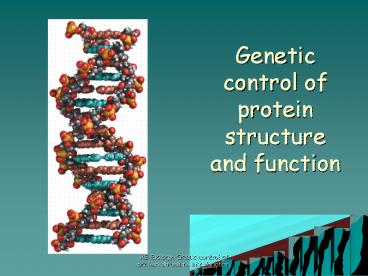Genetic control of protein structure and function - PowerPoint PPT Presentation
Title:
Genetic control of protein structure and function
Description:
Genetic control of protein structure and function The structure of DNA and RNA Genetic material of living organisms is either DNA or RNA. DNA Deoxyribonucleic ... – PowerPoint PPT presentation
Number of Views:63
Avg rating:3.0/5.0
Title: Genetic control of protein structure and function
1
Genetic control of protein structure and function
2
The structure of DNA and RNA
- Genetic material of living organisms is either
DNA or RNA. - DNA Deoxyribonucleic acid
- RNA Ribonucleic acid
- Genes are lengths of DNA that code for particular
proteins.
3
DNA and RNA are polynucleotides
- Both DNA and RNA are polynucleotides.
- They are made up of smaller molecules called
nucleotides. - DNA is made of two polynucleotide strands
- RNA is made of a single polynucleotide strand
Nucleotide
Nucleotide
Nucleotide
Nucleotide
Nucleotide
Nucleotide
Nucleotide
Nucleotide
Nucleotide
Nucleotide
Nucleotide
Nucleotide
Nucleotide
Nucleotide
Nucleotide
Nucleotide
4
Structure of a nucleotide
- A nucleotide is made of 3 components
- A Pentose sugar
- This is a 5 carbon sugar
- The sugar in DNA is deoxyribose.
- The sugar in RNA is ribose.
5
Structure of a nucleotide
- A Phosphate group
- Phosphate groups are important because they link
the sugar on one nucleotide onto the phosphate of
the next nucleotide to make a polynucleotide.
6
Structure of a nucleotide
- A Nitogenous base
- In DNA the four bases are
- Thymine
- Adenine
- Cytosine
- Guanine
- In RNA the four bases are
- Uracil
- Adenine
- Cytosine
- Guanine
7
Nitrogenous bases Two types
- Pyramidines
- Thymine - T
- Cytosine - C
- Uracil - U
- Purines
- Adenine - A
- Guanine - G
8
Adenine
9
Guanine
10
(No Transcript)
11
Sugar phosphate bonds (backbone of DNA)
- Nucleotides are connected to each other via the
phosphate on one nucleotide and the sugar on the
next nucleotide - A Polynucleotide
12
James Watson (L) and Francis Crick (R), and the
model they built of the structure of DNA
13
X-ray diffraction photograph of the DNA double
helix
14
Base pairing
- The Nitrogenous Bases pair up with other bases.
For example the bases of one strand of DNA base
pair with the bases on the opposite strand of the
DNA.
15
(No Transcript)
16
(No Transcript)
17
(No Transcript)
18
The Rule
- Adenine always base pairs with Thymine (or Uracil
if RNA) - Cytosine always base pairs with Guanine.
- This is beacuse there is exactly enough room for
one purine and one pyramide base between the two
polynucleotide strands of DNA.
19
Complementary base pairing
- Purines Pyramidines
- Adenine Thymine
- Adenine Uracil
- Guanine Cytosine
20
Nature of the Genetic Material
- Property 1 - it must contain, in a stable form,
information encoding the organisms structure,
function, development and reproduction - Property 2 - it must replicate accurately so
progeny cells have the same genetic makeup - Property 3 - it must be capable of some variation
(mutation) to permit evolution
21
Replication of DNA and Chromosomes
- Speed of DNA replication 3,000
nucleotides/min in human 30,000
nucleotides/min in E.coli - Accuracy of DNA replication Very precise (1
error/1,000,000,000 nt)
22
(No Transcript)
23
(No Transcript)
24
(No Transcript)
25
Taylor and co-workers (1957)
after one further replication in unlabelled media
3H-labelled chromosomes
26
Meselson and Stahl (1958)
27
(No Transcript)
28
A replicating Drosophila chromosome
29
- Origins initiate replication at different
times.
30
(No Transcript)
31
(No Transcript)
32
(No Transcript)
33
(No Transcript)
34
(No Transcript)
35
(No Transcript)
36
(No Transcript)
37
(No Transcript)
38
This powerpoint was kindly donated to
www.worldofteaching.com http//www.worldofteac
hing.com is home to over a thousand powerpoints
submitted by teachers. This is a completely free
site and requires no registration. Please visit
and I hope it will help in your teaching.































